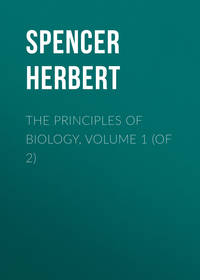 полная версия
полная версияFirst Principles
Here also may properly be added the remark, that to effect these changes in the relative positions of parts, the incident forces must range within certain limits. It is wholly a question of the ratio between those agencies which hold the units in their positions, and those agencies which tend to change their positions. Having given intensities in the powers that oppose re-arrangement, there need proportionate intensities in the powers that work re-arrangement. As there must be neither too great nor too little cohesion; so there must be neither too little nor too great amounts of the influences antagonistic to cohesion. While a slight mechanical strain produces no lasting alterations in the relative positions of parts, an excessive mechanical strain causes disruption – causes so great an alteration in the relative positions of parts as to destroy their union in one aggregate. While a very feeble chemical affinity brought to bear on the associated units, fails to work any re-arrangement of them; a chemical affinity that is extremely intense, destroys their structural continuity, and reduces such complex re-arrangements as have been made, to comparatively simple ones. And while in the absence of adequate thermal undulations, the units have not freedom enough to obey the re-arranging influences impressed on them, the incidence of violent thermal undulations gives them such extreme freedom that they break their connexions, and the aggregate lapses into a liquid or gaseous form.
On the one hand, therefore, the statical forces which uphold the state of aggregation must not be so great as wholly to prevent those changes of relative position among the units which the dynamical forces tend to produce; and, on the other hand, the dynamical forces must not be so great as wholly to overcome the statical forces, and destroy the state of aggregation. The excess of the dynamical forces must be sufficient to produce Evolution, but not sufficient to produce Dissolution.
§ 105. And now we are naturally introduced to a consideration which, though it does not come quite within the limits of this chapter as expressed in its title, may yet be more conveniently dealt with here than elsewhere. Hitherto we have studied the metamorphosis of things, only as exhibited in the changed distribution of matter. It remains to look at it as exhibited in the changed distribution of motion. The definition of Evolution in its material aspect, has to be supplemented by a definition of Evolution in its dynamical aspect.
On inquiring the source of the sensible motions seen in every kind of Evolution, we find them all traceable to insensible motions; either of that tangible matter which we perceive as constituting the objects around us, or of that intangible matter which we infer as occupying space. A brief reconsideration of the facts will make this obvious. The formation of celestial bodies, supposing it caused by the union of dispersed units, must, from the beginning, have involved a diminished motion of these units with respect to each other; and such motion as each resulting body acquired, must previously have existed in the motions of its units. If concrete matter has arisen by the aggregation of diffused matter, then concrete motion has arisen by the aggregation of diffused motion. That which now exists as the movement of masses, implies the cessation of an equivalent molecular movement. Those transpositions of matter which constitute geological changes, are clearly referable to the same source. As before shown, the denudation of lands and deposit of new strata, are effected by water in the course of its descent from the clouds to the sea, or during the arrest of those undulations produced on it by winds; and, as before shown, the elevation of water to the height whence it fell, is due to solar heat, as is also the genesis of those aerial currents which drift it about when evaporated and agitate its surface when condensed. That is to say, the molecular motion of the etherial medium, is transformed into the motion of gases, thence into the motion of liquids, and thence into the motion of solids – stages in each of which, successively, a certain amount of molecular motion is lost and an equivalent motion of masses produced. If we seek the origin of vital movements, we soon reach a like conclusion. The actinic rays issuing from the Sun, enable the plant to reduce special elements existing in gaseous combination around it, to a solid form, – enable the plant, that is, to grow and carry on its functional changes. And since growth, equally with circulation of sap, is a mode of sensible motion, while those rays which have been expended in generating it consist of insensible motions, we have here, too, a transformation of the kind alleged. Animals, derived as their forces are, directly or indirectly, from plants, carry this transformation a step further. The automatic movements of the viscera, together with the voluntary movements of the limbs and body at large, arise at the expense of certain molecular movements throughout the nervous and muscular tissues; and these originally arose at the expense of certain other molecular movements propagated by the Sun to the Earth; so that both the structural and functional motions which organic Evolution displays, are motions of aggregates generated by the arrested motions of units. Even with the aggregates of these aggregates the same rule holds. For among associated men, the progress is ever towards a merging of individual actions in the actions of corporate bodies. An undeveloped society is composed of members between whom there is little concert: they fulfil their several wants without mutual aid; and only on occasions of aggression or defence, act together – occasions on which their combination, small as it is in extent, frequently fails because it is so imperfect. In the course of civilization, however, co-operation becomes step by step more decided. As tribes grow into nations, there result larger aggregates, each of which has a joint political life – a common policy and movement with respect to other aggregates. Legislative and administrative progress, involves an increase in the number of restraining agents brought into united and simultaneous action. In military organization, we see an advance from small undisciplined hordes of armed men, to vast bodies of regular troops, so drilled that the movements of the units are entirely subordinated to the movements of the masses. Nor does industrial development fail to show parallel changes. Beginning with independent workers, and passing step by step to the employment of several assistants by one master, there has ever been, and still is, a progress towards the co-operation of greater masses of labourers in the same establishment, and towards the union of capitalists into more numerous and larger companies: in both which kinds of combined action, equivalent amounts of individual action disappear. Under all its forms, then, Evolution, considered dynamically, is a decrease in the relative movements of parts, and an increase in the relative movements of wholes – using the words parts and wholes in their widest senses. From the infinitesimal motions of those infinitesimal units composing the etherial medium, to the larger though still insensible motions of the larger though still insensible units composing gaseous, fluid, and solid matter, and thence to the visible motions of visible aggregates, the advance is from molecular motion to the motion of masses.
But now what of the converse process? If the foregoing proposition is true, then a change from the motion of masses to molecular motion, is the opposite to Evolution – is Dissolution. Is this so? Of inorganic dissolution we have but little experience; or at least, our experience of it is on too small a scale to exhibit it as the antithesis of Evolution. We know, indeed, that when solids are dissolved in liquids, their dissolution implies increased movements of their units, at the expense of diminished movements among the units of their solvents; and we know that when a liquid evaporates, its dissipation or dissolution similarly implies greater relative movements of the units, and decrease of such combined movement as they before had. But since these small aggregates of inorganic matter, do not exhibit the phenomena of Evolution, save in the form of simple integration; so they do not exhibit the phenomena of dissolution, save in the form of simple disintegration. Of organic dissolution, however, our experience suffices to show that it is a decrease of combined motion, and an increase in the motion of uncombined parts. The gradual cessation of functions, vegetal or animal, is a cessation of the sensible movements of fluids and solids. In animals, the impulsions of the body from place to place, first cease; presently the limbs cannot be stirred; later still the respiratory actions stop; finally the heart becomes stationary, and, with it, the circulating fluids. That is, the transformation of molecular motion into the motion of masses, comes to an end. What next takes place? We cannot say that sensible movements are transformed into insensible movements; for sensible movements no longer exist. Nevertheless, the process of decay involves an increase of insensible movements; since this is far greater in the gases generated by decomposition, than it is in the fluid-solid matters generating them. Indeed, it might be contended that as, during Dissolution, there is a change from the vibration of large compound atoms to the vibration of small and comparatively simple ones, the process is strictly antithetical to that of Evolution. In conformity with the now current conception lately explained, each of the highly complex chemical units composing an organic body, possesses a rhythmic movement – a movement in which its many component units jointly partake. When decomposition breaks up these highly complex atoms, and their constituents assume a gaseous form, there is both an increase of molecular motion implied by the diffusion, and a further increase implied by the resolving of such motions as the aggregate atoms possessed, into motions of their constituent atoms. So that in organic dissolution we have, first, an end put to that transformation of the motion of units into the motion of aggregates, which constitutes Evolution, dynamically considered; and we have also, though in a subtler sense, a transformation of the motion of aggregates into the motion of units. The formula equally applies to the dissolution of a society. When social ties, be they governmental or industrial, are destroyed, the combined actions of citizens lapse into uncombined actions. Those general forces which restrained individual doings, having disappeared, the only remaining restraints are those separately exercised by individuals on each other. There are no longer any of the joint operations by which men satisfy their wants; and, in so far as they can, they satisfy their wants by separate operations. That is to say, the movement of parts replaces the movement of wholes.
Under its dynamical aspect then, Evolution, so far as we can trace it, is a change from molecular motion to the motion of masses; while Dissolution, so far as we can trace it, is a change from the motion of masses to molecular motion.
§ 106. To these abstract definitions may be added concrete ones. Besides an integration of motions corresponding to the integration of masses, Evolution involves an increase in the multiformity of the motions, corresponding to the increase in the multiformity of the masses. If, contemplating it as materially displayed, we find Evolution to consist in the change from an indefinite, homogeneous distribution of parts to a definite, heterogeneous distribution of parts; then, contemplating Evolution as dynamically displayed, it consists in a change from indefinite, homogeneous motions to definite, heterogeneous motions.
This change takes place under the form of an increased variety of rhythms. We have already seen that all motion is rhythmical, from the infinitesimal vibrations of infinitesimal molecules, up to those vast oscillations between perihelion and aphelion performed by vast celestial bodies. And as the contrast between these extreme cases suggests, a multiplication of rhythms must accompany a multiplication in the degrees and modes of aggregation, and in the relations of the aggregated masses to incident forces. The degree or mode of aggregation will not, indeed, affect the rate or extent of rhythm where the incident force increases as the aggregate increases, which is the case with gravitation: here the only cause of variation in rhythm, is difference of relation to the incident forces; as we see in a pendulum, which, though unaffected in its movements by a change in the weight of the bob, alters its rate of oscillation when taken to the equator. But in all cases where the incident forces do not vary as the masses, every new order of aggregation initiates a new order of rhythm: witness the conclusion drawn from the recent researches into radiant heat and light, that the atoms of different gases have different rates of undulation. So that increased multiformity in the arrangement of matter, has necessarily generated increased multiformity of rhythm; both through increased variety in the sizes and forms of aggregates, and through increased variety in their relations to the forces which move them. The advancing heterogeneity of motion, thus entailed by advancing heterogeneity in the distribution of matter, does not, however, end here. Besides multiplication in the kinds of rhythm, there is a progressing complexity in their combinations. As there arise wholes composed of heterogeneous parts, each of which has its own rhythm, there must arise compound rhythms proportionately heterogeneous. We before saw that this is visible even in the cyclical perturbations of the Solar System – simple as are its structure and movements. And when we contemplate highly-developed organic bodies, we find the complication of rhythms so great, that it defies definite analysis, and from moment to moment works out in resultants that are incalculable.
This conception of Evolution forms a needful complement to that on which we have hitherto chiefly dwelt. To comprehend the phenomena in their entirety, we have to contemplate both the increasing multiformity of parts, and the increasing multiformity of the actions simultaneously assumed by these parts. At the same time that there are differentiations and integrations of the matter, there are differentiations and integrations of its motion. And this increasingly heterogeneous distribution of motion, constitutes Evolution functionally considered; as distinguished from that increasingly heterogeneous distribution of matter, which constitutes Evolution structurally considered. While of course, Dissolution exhibits the transition to a reverse distribution, both structurally and functionally.
§ 107. One other preliminary must be set down. When specifically interpreting Evolution, we shall have to consider under their concrete forms, the various resolutions of force that follow its conflict with matter. Here it will be well to contemplate such resolutions under their most general or abstract forms.
Any incident force is primarily resolvable or divisible into its effective and non-effective portions. In mechanical impact, the entire momentum of a striking body is never communicated to the body struck: even under those most favourable conditions in which the striking body loses all its sensible motion, there still remains with it a portion of the original momentum, under the shape of that insensible motion produced among its particles by the collision. Of the light or heat falling on any mass, a part, more or less considerable, is reflected; and only the remaining part works molecular changes in the mass. Next it is to be noted that the effective force, is itself divisible into the temporarily effective and the permanently effective. The units of an aggregate acted on, may undergo those rhythmical changes of relative position which constitute increased vibration, as well as other changes of relative position which are not from instant to instant neutralized by opposite ones. Of these, the first, disappearing in the shape of radiating undulations, leave the molecular arrangement as it originally was; while the second conduce to that re-arrangement constituting Evolution. Yet a further distinction has to be made. The permanently effective force works out changes of relative position of two kinds – the insensible and the sensible. The insensible transpositions among the units are those constituting what we call chemical composition and decomposition; and it is these which we recognize as the qualitative differences that arise in an aggregate. The sensible transpositions are such as result when certain of the units, instead of being put into different relations with their immediate neighbours, are carried away from them and united together elsewhere.
Concerning these divisions and sub-divisions of any force affecting an aggregate, the fact which it chiefly concerns us to observe, is, that they are complementary to each other. Of the whole incident force, the effective must be that which remains after deducting the non-effective. The two parts of the effective force must vary inversely as each other: where much of it is temporarily effective, little of it can be permanently effective; and vice versâ. Lastly, the permanently effective force, being expended in working both the insensible re-arrangements which constitute chemical modification, and the sensible re-arrangements which result in structure, must generate of either kind an amount that is great or small in proportion as it has generated a small or great amount of the other.
§ 108. And now of the propositions grouped together in this chapter, it may be well to remark that, in common with foregoing propositions, they have for their warrant the fundamental truth with which our synthesis set out.
That when a given force falls on any aggregate, the permanently effective part of it will produce an amount of re-arrangement that is inversely proportional to the cohesion existing among the parts of the aggregate, is demonstrable à priori. Whether the cohesion be mechanical or chemical, or whether it be temporarily modified by a changed degree of molecular vibration, matters not to the general conclusion. In all these cases it follows from the persistence of force, that in proportion as the units offer great resistance to alteration in their relative positions, must the amount of motion which a given force impresses on them be small. The proposition is in fact an identical one; since the cohesion of units is known to be great or small, only by the smallness or greatness of the re-arrangement which a given incident force produces.
The continuity of motion we found to be a corollary from the persistence of force; and from the continuity of motion, it follows that molecular motion and the motion of masses can be respectively increased only at each other’s expense. Hence, if in the course of Evolution there arises a motion of masses that did not before exist, there must have ceased an equivalent molecular motion; and if in the course of Dissolution there arises a molecular motion that did not before exist, an equivalent motion of masses must have disappeared.
Equally necessary is the conclusion that the several results of the force expended on any aggregate, must be complementary to each other. It is not less obviously a corollary from the persistence of force, that of the whole incident force the effective is the part which remains after deducting the non-effective; than it is, that of the effective force, whatever does not work permanent results, works temporary results, and that such amount of the permanently effective force as is not absorbed in producing insensible re-arrangements, will produce sensible re-arrangements.
CHAPTER XIII.
THE INSTABILITY OF THE HOMOGENEOUS. 16
§ 109. Thus far our steps towards the interpretation of Evolution have been preparatory. We have dealt with the factors of the process, rather than the process itself. After the ultimate truth that, Matter, Motion, and Force, as cognizable by human intelligence, can neither come into existence nor cease to exist, we have considered certain other ultimate truths concerning the modes in which Force and Motion are manifested during the changes they produce in Matter. Now we have to study the changes themselves. We have here to analyze that re-arrangement in the parts of Matter, which occurs under the influence of Force, that is unchangeable in quantity though changeable in form, through the medium of Motion taking place rhythmically along lines of least resistance. The proposition which comes first in logical order, is, that some re-arrangement must result; and this proposition may be best dealt with under the more specific shape, that the condition of homogeneity is a condition of unstable equilibrium.
First, as to the meaning of the terms; respecting which some readers may need explanation. The phrase unstable equilibrium is one used in mechanics to express a balance of forces of such kind, that the interference of any further force, however minute, will destroy the arrangement previously subsisting; and bring about a totally different arrangement. Thus, a stick poised on its lower end is in unstable equilibrium: however exactly it may be placed in a perpendicular position, as soon as it is left to itself it begins, at first imperceptibly, to lean on one side, and with increasing rapidity falls into another attitude. Conversely, a stick suspended from its upper end is in stable equilibrium: however much disturbed, it will return to the same position. The proposition is, then, that the state of homogeneity, like the state of the stick poised on its lower end, is one that cannot be maintained. Let us take a few illustrations.
Of mechanical ones the most familiar is that of the scales. If they be accurately made, and not clogged by dirt or rust, it is impossible to keep a pair of scales perfectly balanced: eventually one scale will descend and the other ascend – they will assume a heterogeneous relation. Again, if we sprinkle over the surface of a fluid a number of equal-sized particles, having an attraction for each other, they will, no matter how uniformly distributed, by and by concentrate irregularly into one or more groups. Were it possible to bring a mass of water into a state of perfect homogeneity – a state of complete quiescence, and exactly equal density throughout – yet the radiation of heat from neighbouring bodies, by affecting differently its different parts, would inevitably produce inequalities of density and consequent currents; and would so render it to that extent heterogeneous. Take a piece of red-hot matter, and however evenly heated it may at first be, it will quickly cease to be so: the exterior, cooling faster than the interior, will become different in temperature from it. And the lapse into heterogeneity of temperature, so obvious in this extreme case, takes place more or less in all cases. The action of chemical forces supplies other illustrations. Expose a fragment of metal to air or water, and in course of time it will be coated with a film of oxide, carbonate, or other compound: that is – its outer parts will become unlike its inner parts. Usually the heterogeneity produced by the action of chemical forces on the surfaces of masses, is not striking; because the changed portions are soon washed away, or otherwise removed. But if this is prevented, comparatively complex structures result. Quarries of trap-rock contain some striking examples. Not unfrequently a piece of trap may be found reduced, by the action of the weather, to a number of loosely-adherent coats, like those of an onion. Where the block has been quite undisturbed, we may trace the whole series of these, from the angular, irregular outer one, through successively included ones in which the shape becomes gradually rounded, ending finally in a spherical nucleus. On comparing the original mass of stone with this group of concentric coats, each of which differs from the rest in form, and probably in the state of decomposition at which it has arrived, we get a marked illustration of the multiformity to which, in lapse of time, a uniform body may be brought by external chemical action. The instability of the homogeneous is equally seen in the changes set up throughout the interior of a mass, when it consists of units that are not rigidly bound together. The atoms of a precipitate never remain separate, and equably distributed through the fluid in which they make their appearance. They aggregate either into crystalline grains, each containing an immense number of atoms, or they aggregate into flocculi, each containing a yet larger number; and where the mass of fluid is great, and the process prolonged, these flocculi do not continue equidistant, but break up into groups. That is to say, there is a destruction of the balance at first subsisting among the diffused particles, and also of the balance at first subsisting among the groups into which these particles unite. Certain solutions of non-crystalline substances in highly volatile liquids, exhibit in the course of half an hour a whole series of changes that are set up in the alleged way. If for example a little shell-lac-varnish (made by dissolving shell-lac in coal-naphtha until it is of the consistence of cream) be poured on a piece of paper, the surface of the varnish will shortly become marked by polygonal divisions, which, first appearing round the edge of the mass, spread towards its centre. Under a lense these irregular polygons of five or more sides, are seen to be severally bounded by dark lines, on each side of which there are light-coloured borders. By the addition of matter to their inner edges, the borders slowly broaden, and thus encroach on the areas of the polygons; until at length there remains nothing but a dark spot in the centre of each. At the same time the boundaries of the polygons become curved; and they end by appearing like spherical sacs pressed together; strangely simulating (but only simulating) a group of nucleated cells. Here a rapid loss of homogeneity is exhibited in three ways: – First, in the formation of the film, which is the seat of these changes; second, in the formation of the polygonal sections into which this film divides; and third, in the contrast that arises between the polygonal sections round the edge, where they are small and early formed, and those in the centre which are larger and formed later.









